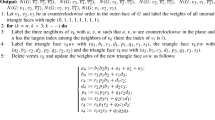Abstract
We present a randomized algorithm for finding maximum matchings in planar graphs in timeO(n ω/2), whereω is the exponent of the best known matrix multiplication algorithm. Sinceω<2.38, this algorithm breaks through theO(n 1.5) barrier for the matching problem. This is the first result of this kind for general planar graphs. We also present an algorithm for generating perfect matchings in planar graphs uniformly at random usingO(n ω/2) arithmetic operations. Our algorithms are based on the Gaussian elimination approach to maximum matchings introduced in [16].
Similar content being viewed by others
References
Blum, N.: A new approach to maximum matching in general graphs. In:Proc. 17th ICALP, Volume 443 of LNCS, Springer-Verlag, Berlin, 1990, pp. 586–597.
Bunch, J., Hopcroft, J.: Triangular factorization and inversion by fast matrix multiplication.Math. Comp. 28 (1974), 231–236.
Coppersmith, D., Winograd, S.: Matrix multiplication via arithmetic progressions. In:Proceedings of the Nineteenth Annual ACM Conference on Theory of Computing, ACM Press, New York, 1987, pp. 1–6.
Edmonds, J.: Paths, trees and flowers.Canad. J. Math. 17 (1965), 449–467.
Gabow, H.N., Tarjan, R.E.: Faster scaling algorithms for general graph matching problems.J. ACM 38 (1991), 815–853.
Harary, F., editor:Graph Theory and Theoretical Physics. Academic Press, New York, 1967.
Khaira, M.S., Miller, G.L., Sheffler, T.J.: Nested dissection: a survey, Technical Report CS-92-106, 1992.
Klein, P., Rao, S., Rauch, M., Subramanian, S.: Faster shortest-path algorithms for planar graphs. In:Proceedings of the Twenty-Sixth Annual ACM Symposium on Theory of Computing, ACM Press, New York, 1994, pp. 27–37.
Kowalewski, G.:Einfuhrung in die Determinanten Theorie. Leipzig Verlag von Veit & Co, Leipzig, 1909.
Lipton, R.J., Rose, D.J., Tarjan, R.: Generalized nested dissection.SIAM J. Numer. Anal. 16 (1979), 346–358.
Lipton, R.J., Tarjan, R.E.: A separator theorem for planar graphs.SIAM J. Appl. Math. 36 (1979), 177–189.
Lipton, R.J., Tarjan, R.E.: Applications of a planar separator theorem.SIAM J. Comput. 9 (1980), 615–627.
Lovász, L.: On determinants, matchings and random algorithms. In Budach, L., ed.:Fundamentals of Computation Theory, Akademie-Verlag, Berlin, 1979, pp. 565–574.
Micali, S., Vazirani, V.V.: Ano(√|V||e|) algorithm for finding maximum matching in general graphs. In:Proceedings of the Twenty-First Annual IEEE Symposium on Foundations of Computer Science, 1980, pp. 17–27.
Miller, G.L., Naor, J.: Flow in planar graphs with multiple sources and sinks. In:Proceedings of the 30th IEEE Symposium on Foundations of Computer Science, 1989, pp. 112–117.
Mucha, M., Sankowski, P.: Maximum matchings via gaussian elimination. In:Proceedings of the 45th Annual IEEE Symposium on Foundations of Computer Science, 2004, pp. 248–255.
Pan, V.Y., Reif, J.H.: Fast and efficient parallel solution of sparse linear systems.SIAM J. Comput. 22 (1993), 1227–1250.
Rabin, M.O., Vazirani, V.V.: Maximum matchings in general graphs through randomization.J. Algorithms 10 (1989), 557–567.
Schwartz, J.: Fast probabilistic algorithms for verification of polynomial identities.J. ACM 27 (1980), 701–717.
Strassen, V.: Gaussian elimination is not optimal.Numer. Math. 13 (1969), 354–356.
Tutte, W.T.: The factorization of linear graphs.J. London Math. Soc. 22 (1947), 107–111.
Wilson, D.B.: Determinant algorithms for random planar structures. In:Proceedings of the Eighth Annual ACM-SIAM Symposium on Discrete Algorithms, Society for Industrial and Applied Mathematics, Philadelphia, PA, 1997, pp. 258–267.
Zippel, R.: Probabilistic algorithms for sparse polynomials. In:International Symposium on Symbolic and Algebraic Computation, Volume 72 of LNCS, Springer-Verlag, Berlin, 1979, pp. 216–226.
Author information
Authors and Affiliations
Corresponding author
Additional information
This research was supported by KBN Grant 4T11C04425.
Rights and permissions
About this article
Cite this article
Mucha, M., Sankowski, P. Maximum matchings in planar graphs via gaussian elimination. Algorithmica 45, 3–20 (2006). https://doi.org/10.1007/s00453-005-1187-5
Received:
Revised:
Issue Date:
DOI: https://doi.org/10.1007/s00453-005-1187-5




